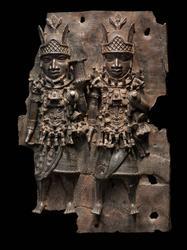Advanced Search 

Thumbnail-size images of copyrighted artworks are displayed under fair use, in accordance with guidelines recommended by the Code of Best Practices in Fair Use for the Visual Arts, published by the College Art Association in February 2015.
Relief plaque showing two warriors
Edo, Benin kingdom, Nigeria
c. 1530-1570
Medium/Technique
Copper alloy
Dimensions
Length x width: 47 x 30.5 cm (18 1/2 x 12 in.)
Credit Line
Robert Owen Lehman Collection
Accession NumberL-G 7.29.2012
CollectionsAfrica and Oceania
ClassificationsPlaques
This bronze plaque is part of a set of more than 800 that once decorated the pillars in the audience hall of the Oba, or king, of Benin. The two men on this plaque are wearing warrior's gear, including leopard-tooth necklaces, bells attached to their chests with a length of rope, and bells hanging from their waists to make a racket when approaching the enemy. The crowns with projecting feathers are distinctive, and likely connect these men to a particular militia. The MFA collection includes other plaques depicting the same figures. The leather jerkins the men wear offer some protection from arrows and sword blows, while the leopard face decoration signals their allegiance to the Oba, who is often compared to a leopard. The circular box held by one of the men is a special kind of container, called an ekpokin, that is used to bring tribute payments to the Oba from his subjects, or to bring gifts from the Oba to a member of the court. The box is made of leopard-skin, which has a distinctive pattern, a further clue that the contents of the box are associated with the palace.
Provenance16th century, commissioned by Oba Esigie (r. 1517-1550s) or his son Oba Orhogbua (r. 1550s-1570s), Royal Palace, Benin City; by descent to Oba Ovonramwen (Ovonramwen Nogbaisi, b. about 1857 – d. about 1914; r. 1888 - 1897); 1897, probably looted from the Royal Palace during the British military occupation of Benin. J.J. Klejman (dealer; b. 1906 – d. 1995), New York; sold by Klejman to Robert Owen Lehman, Rochester, NY; 2012, promised gift of Robert Owen Lehman to the MFA.
ADDITIONAL INFORMATION:
Although the early provenance of this object is not recorded, it is likely that British forces took it from the Royal Palace in Benin City in 1897. At that time troops occupied the city and seized approximately 4,000 works of art as spoils of war; these objects then made their way to European collectors, dealers, and museums. It is also possible that it left Benin City at a later date or by other means that have not been documented.
ADDITIONAL INFORMATION:
Although the early provenance of this object is not recorded, it is likely that British forces took it from the Royal Palace in Benin City in 1897. At that time troops occupied the city and seized approximately 4,000 works of art as spoils of war; these objects then made their way to European collectors, dealers, and museums. It is also possible that it left Benin City at a later date or by other means that have not been documented.
